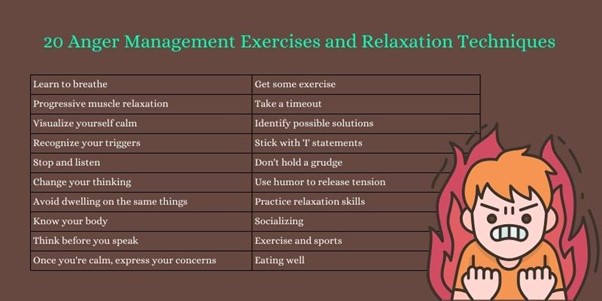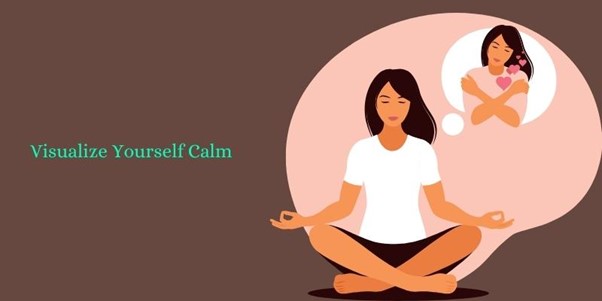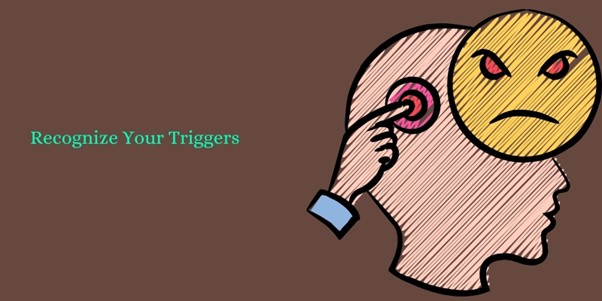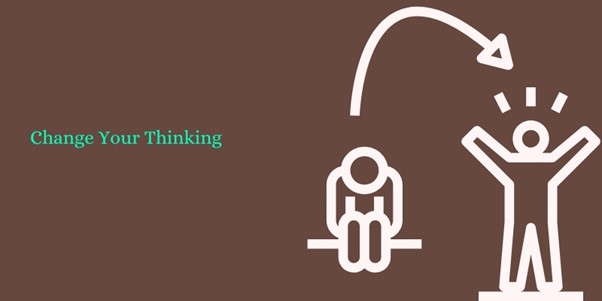Anger Management Exercises And Relaxation Techniques
Unmanaged anger can lead to real problems in daily life, impacting work, relationships, and personal well-being.
Studies show that about one in every ten Americans struggles with anger issues, and a significant number report that these feelings have had a negative impact on their lives.
Managing anger is important for both mental and physical health, as uncontrolled anger is directly associated with stress, anxiety, high blood pressure, and even heart problems.
One of the most effective ways to address anger issues is to practice anger management exercises.
These exercises focus on helping individuals understand and control their anger rather than allowing it to dictate their actions.
Whether it’s deep breathing techniques, muscle relaxation, or mental exercises to shift perspective, these strategies can significantly affect how people handle their emotions.
This blog will walk you through some of the most effective anger management exercises anyone can try. These techniques are practical, easy to incorporate into daily routines, and proven to help reduce anger responses.
By learning and practicing these exercises, you can take an important step towards a more balanced life.
20 Most Effective Anger Management Exercises and Relaxation Techniques

Anger is a natural and healthy emotion, but managing it effectively can be challenging. For many, understanding how to control anger requires a combination of relaxation techniques and anger management exercises.
These strategies help reduce the intensity of anger and enable individuals to handle emotions in a balanced way.
1. Learn to Breathe

One of the most fundamental techniques for managing anger is learning to control your breathing.
When anger arises, breathing becomes rapid and shallow, intensifying feelings of rage. Controlled, deep breathing, however, calms the nervous system, promotes oxygen flow, and can ease tension throughout the body.
By focusing on breathing, you shift your attention away from the triggering thoughts, allowing you to approach the situation with a clearer mind.
To practice controlled breathing:
- Find a quiet space: Sit or stand comfortably, away from distractions.
- Inhale deeply: Breathe through your nose, counting slowly to four, and let your abdomen expand.
- Hold your breath: Pause for a second or two.
- Exhale slowly: Breathe out through your mouth, counting again to four, and release the air completely from your lungs.
- Repeat: Continue this cycle for a few minutes, focusing solely on your breathing.
This exercise reduces anger quickly, encouraging a more balanced response to intense emotions.
Regular breathing exercises can make it a natural response when anger arises, providing you with a simple, accessible tool to regain calmness.
2. Progressive Muscle Relaxation (PMR)

Progressive Muscle Relaxation (PMR) is a valuable technique for releasing physical tension, often accompanying anger.
PMR involves systematically tensing and relaxing different muscle groups, promoting awareness of tension points, and relieving stress.
This technique reduces anger and provides a calming effect as you focus on the sensations in your body rather than the anger trigger.
To practice PMR:
- Get comfortable: Sit or lie down in a quiet place where you won’t be disturbed.
- Begin with your toes: Tense the muscles in your toes, hold the tension for 5-10 seconds, then release, focusing on the sensation as the muscles relax.
- Move through each muscle group: Progressively tense and relax each area, including your legs, abdomen, chest, arms, hands, shoulders, neck, and face.
- Focus on breathing: Take deep breaths as you relax each muscle group, paying attention to how your body feels with each release of tension.
- Visualize calmness: Imagine a wave of relaxation flowing through your body with each exhalation.
Practicing PMR can make you more aware of your body’s response to anger and stress, helping you notice and release tension before it builds up.
3. Visualize Yourself Calm

Visualization is a powerful tool for managing anger. By picturing yourself calm in a heated situation, you can shift your focus from anger to a peaceful state of mind.
This technique uses mental imagery to place you in control, reducing the intensity of your emotions.
Visualization works because the mind often responds to images similarly to real-life situations, allowing you to feel the benefits of calmness simply by imagining it.
To practice visualization:
- Find a quiet space: Sit or lie comfortably, closing your eyes to focus.
- Create a calming image: Imagine a place where you feel safe and at peace, like a beach, mountain, or forest. Picture yourself in this place, noticing the surrounding details—the sounds, smells, and sensations.
- Visualize yourself handling anger well: Imagine a scenario where you’re calm and collected during a situation that might normally provoke anger. See yourself breathing steadily, responding thoughtfully, and maintaining a relaxed demeanor.
- Hold onto that feeling: Stay in this mental image for a few minutes, focusing on how calm and in control you feel.
Practicing visualization regularly can help you access calm thoughts during moments of anger. Over time, you may find it easier to respond thoughtfully in tense situations as your mind recalls the peaceful states you’ve practiced.
4. Recognize Your Triggers

One of the most proactive ways to manage anger is to identify triggers, this can be done by anger management assessment. Triggers are situations, people, or experiences that spark anger more easily.
Recognizing what causes your anger can help you prepare for and respond to these situations more effectively rather than reacting impulsively.
To recognize your triggers:
- Reflect on past anger: Take some time to think about recent situations where you felt angry. Write down what was happening, who was involved, and how you felt before, during, and after.
- Identify patterns: Look for recurring themes or specific triggers. Are there certain topics, environments, or people that consistently lead to anger?
- Monitor your emotions: Keep a journal where you record any episodes of anger, including what triggered it and how you reacted. This can help you spot patterns over time.
- Prepare coping strategies: Once you know your triggers, develop specific strategies to handle each one. For example, if waiting in traffic is a trigger, practicing deep breathing or listening to calming music can help you stay grounded.
Recognizing your triggers empowers you to handle anger with more intention. It allows you to anticipate potential stressors and approach them with a prepared response rather than a reactive one.
5. Stop and Listen

The “Stop and Listen” technique encourages you to pause before reacting, allowing time for reflection and a more controlled response.
Often, anger can lead to impulsive reactions that we might later regret.
Stopping and listening to your thoughts, emotions, and what others are saying creates a buffer between your anger and your actions, which helps manage conflicts or misunderstandings.
To practice stopping and listening:
- Pause when you feel anger building: As soon as you recognize the signs of anger, such as a quickened heartbeat or tense muscles, take a brief pause. Acknowledge your anger without acting on it.
- Focus on listening: If you’re in a conversation, listen carefully to the other person’s words. Sometimes, anger can distort perception, so focusing on listening helps clarify misunderstandings. If you’re alone, listen to your own thoughts and feelings—ask yourself why you’re angry and what underlying emotion might be present.
- Breathe deeply: During this pause, taking a few deep breaths can help you center yourself and slow down your reaction.
- Choose your response thoughtfully: After listening and breathing, think about how you want to respond. This pause allows you to communicate your feelings more calmly and clearly.
By practicing the “Stop and Listen” technique, you can prevent anger from controlling your responses, especially in situations involving others.
6. Change Your Thinking

Changing how you think is essential in managing anger effectively. Often, anger is fueled by negative or distorted thoughts, such as blaming, exaggerating, or assuming the worst about people or situations.
By actively shifting your thought patterns, you can lessen the impact of anger and respond to situations with greater clarity and control.
To change your thinking:
- Challenge automatic negative thoughts: When anger rises, pause to assess the thoughts that triggered it. Are you assuming bad intentions or imagining the worst-case scenario? Recognize these thoughts and ask yourself if they’re realistic.
- Reframe the situation: Replace negative thoughts with more balanced ones. For instance, if someone cuts you off in traffic, instead of thinking, “They’re so rude!” try thinking, “They might be in a rush for a reason.” This shift helps reduce the intensity of your anger.
- Practice gratitude and positive affirmations: Focus on what’s going right in your day or things you’re grateful for. This change in perspective can help create a more positive mental state, making you less reactive to minor annoyances.
- Use “I” statements: When discussing an upsetting situation, focus on expressing your feelings without blaming others. Instead of “You never listen!” try “I feel ignored when I’m not heard.”
By challenging unhelpful thoughts, you can minimize anger’s control over your reactions and build a more positive mindset, promoting healthier interactions and reduced stress.
7. Avoid Dwelling on the Same Things

Constantly replaying an upsetting event can amplify anger and frustration, keeping you locked in negative emotions.
When you dwell on anger-inducing thoughts, your mind repeatedly re-experiences the stress, making it harder to move forward and respond calmly to new situations.
To avoid dwelling on anger:
- Distract yourself with activities: Engage in hobbies, exercise, or tasks that require focus. These activities can take your mind off the anger and help you process it in a healthier way.
- Set a time limit for venting: Allow yourself a few minutes to acknowledge what’s bothering you, then consciously decide to shift your focus. Talk about the issue with a friend or write it down to release it.
- Focus on problem-solving: If you’re upset about a specific issue, consider what constructive actions you can take to address it. For example, if work stress is a trigger, list steps to better manage your workload rather than replaying frustrating moments.
- Practice mindfulness and grounding: Bring yourself back to the present moment using deep breathing, grounding techniques, or sensory exercises like noticing textures, colors, or sounds around you.
By training yourself to break out of the loop, you can reduce overall stress and feel more in control of your emotional state.
8. Know Your Body

Understanding how your body reacts to anger is key to managing it effectively.
Physical signs of anger like tense muscles, clenched fists, rapid breathing, or increased heart rate are the body’s natural response to perceived threats.
Recognizing these signs early on allows you to take preventive measures before your anger escalates.
To better know your body:
- Identify your physical cues: Take note of how anger shows up in your body. Is it tightness in your chest, a flushed face, or shaky hands? Once you recognize these signs, you’ll be more attuned to your emotional state.
- Practice body scanning: Regularly check in with different parts of your body, scanning from head to toe to identify areas of tension. This technique is beneficial during moments of mild stress to catch and address anger signals early.
- Use relaxation techniques: As soon as you notice anger building, use quick, calming techniques to counteract it. Slow, deep breathing or progressive muscle relaxation (tensing and releasing each muscle group) can help ease physical tension.
- Keep track of patterns: Reflect on situations where these bodily reactions occur and identify common triggers. For example, if tight shoulders are common during work meetings, it could indicate stress around work-related issues.
With practice, you’ll develop better self-awareness and be more proactive in managing your reactions, making it easier to respond thoughtfully and reduce the chance of outbursts.
9. Think Before You Speak

Thinking before you speak is a fundamental practice in managing anger effectively.
When emotions run high, it’s easy to say hurtful or irrational things, leading to further conflict and regret.
Considering your words helps you communicate constructively, avoid escalation, and maintain respectful relationships.
Here’s how to think before you speak:
- Take a moment to pause: When you feel anger building, try to pause before responding. Count to ten or take a few slow breaths. This brief pause allows your brain to move from a reactionary state to a thoughtful one, allowing you to choose your words carefully.
- Assess the goal of your response: Ask yourself what you want to accomplish with your words. Is it to resolve the issue, express your feelings, or find a solution? Focusing on your goal makes you more likely to communicate in a way that promotes understanding rather than fueling the argument.
- Choose respectful language: Avoid making accusatory or generalized statements like “You always” or “You never.” Instead, use specific, factual language that focuses on your perspective. For instance, say, “I feel frustrated when this happens” instead of “You never listen to me.” This approach reduces the chance of the other person becoming defensive.
- Visualize the impact of your words: Imagine how your words will affect the listener. Will they make them feel attacked or help them understand your viewpoint? This exercise can help you choose words that maintain respect and empathy, even in heated situations.
This habit can lead to healthier communication, improved problem-solving, and reduced hurtful exchanges, building stronger connections with those around you.
10. Once You’re Calm, Express Your Concerns

Expressing concerns after you’ve calmed down is essential for addressing issues constructively. When anger is fresh, it’s easy to react impulsively, often leading to unproductive arguments.
Waiting until you’re calm allows you to articulate your concerns more thoughtfully, making it easier for others to understand your perspective and reducing the chance of conflict.
To express concerns after calming down:
- Give yourself time to cool off: Take a few moments to let the intensity of your anger subside. This may involve taking deep breaths, walking away for a short break, or practicing a relaxation exercise. Returning to the conversation once calm helps ensure you’ll speak from a place of reason rather than reaction.
- Be specific and focus on the issue: Vague complaints often lead to defensiveness, so it’s essential to be clear and direct about what bothered you. Stick to one concern at a time rather than overwhelming the other person with a list of grievances, making it easier to find solutions.
- Stay open to listening: Expressing your concerns calmly is only half of the conversation. Be ready to listen to the other person’s perspective as well. Active listening shows that you value their viewpoint, making it more likely that they’ll reciprocate and work towards a resolution.
By waiting until you’re calm to express concerns, you’re more likely to communicate effectively and find solutions that satisfy both parties. This approach also help to control anger in relationships.
11. Get Some Exercise

Exercise is one of the most effective ways to manage anger. Physical activity can release pent-up energy, reduce stress, and trigger the release of endorphins, hormones that help improve mood and reduce feelings of anger and frustration.
Incorporating exercise into your routine helps you manage anger at the moment and builds long-term resilience to stress.
Here’s how exercise can help with anger management:
- Engage in aerobic activities: Activities like running, cycling, or swimming can provide an immediate outlet for intense feelings. These activities increase your heart rate and use large muscle groups, helping to release tension and improve your mood. Even a brisk walk can help dissipate negative energy when you feel anger bubbling up.
- Practice mindful exercise: Yoga, tai chi, or stretching exercises are particularly helpful for managing anger because they combine physical activity with mental focus and deep breathing. These exercises encourage relaxation, increase body awareness, and provide tools to calm yourself in anger-provoking situations.
- Use exercise as a preventive measure: Regular exercise can help build emotional resilience. Studies show that people who engage in physical activity can better cope with stress and manage emotions, including anger. Consider incorporating exercise into your daily or weekly routine to improve your baseline mood and reduce overall stress.
- Channel your anger productively: Physical exercise, particularly sports or weightlifting, allows you to use anger productively without directing it at others. By focusing on physical exertion, you can release negative energy and feel more balanced.
Whether through aerobic workouts, mindful movement, or consistent physical activity, exercise helps reduce the intensity of anger, allowing you to handle challenging situations more effectively and with a clearer mindset.
12. Take a Timeout

Taking a timeout is a powerful anger management strategy that allows individuals to step away from a frustrating situation, cool down, and regain control over their emotions.
Timeouts are especially helpful when anger might lead to impulsive actions or words that could escalate the conflict.
When used correctly, a timeout offers a much-needed mental break, making it easier to respond thoughtfully rather than react impulsively.
Here’s how to take a timeout effectively:
- Recognize when it’s needed: Physical symptoms like a racing heartbeat, clenched fists, or a raised voice often indicate that anger is intensifying. Acknowledging these signs and taking a timeout can prevent anger from boiling over.
- Communicate the need for a break: If you’re in a discussion or argument, let the other person know you need a moment to step away to cool off. Assure them that you’ll return to the conversation after calming down. This shows respect for the discussion and signals that you’re committed to resolving the issue at a more manageable emotional level.
- Engage in a calming activity: During the timeout, do something that relaxes you—whether deep breathing, listening to calming music, or taking a walk. The goal is to redirect your energy and clear your mind to approach the issue with a balanced mindset. Avoid ruminating on the conflict, as that could only fuel anger further.
- Return with clarity: After a few minutes—or however long you need to calm down—return to the situation with a clearer perspective. You’ll be more likely to engage in a constructive dialogue, making it easier to find a resolution without letting emotions cloud your judgment.
Recognizing when to step away increases your chances of handling challenging situations calmly and constructively, ultimately leading to more positive outcomes in your interactions.
13. Identify Possible Solutions

When anger arises, it’s often because of frustration over a problem that seems difficult to solve.
Focusing on identifying possible solutions, rather than dwelling on the problem, shifts your energy toward positive action and away from anger.
This approach empowers you to take control, reduces feelings of helplessness, and helps prevent anger from escalating further.
Here’s how to identify solutions when dealing with anger:
- Pinpoint the root cause: Before jumping to solutions, make sure you understand what triggered your anger in the first place. Sometimes, anger is a response to unmet needs or unresolved issues. Take a moment to reflect on what specifically upset you, whether it’s a miscommunication, unmet expectation, or feeling of disrespect.
- Brainstorm potential solutions: Once you’ve identified the root cause, brainstorm solutions. Try to think creatively and consider multiple options. For instance, if you’re frustrated with a partner over household responsibilities, consider solutions like creating a shared task list or dividing chores in a way that feels fair to both of you.
- Evaluate and choose a solution: Once you have a list of possible solutions, evaluate each in terms of feasibility, potential impact, and how it aligns with your goals. Choose the most likely solution to resolve the issue without causing additional tension. This step gives you a clear action plan and helps alleviate the feeling of being stuck.
- Take action and review: Put your chosen solution into practice and monitor the results. If it doesn’t work as expected, revisit your list and consider trying another approach. Sometimes, resolving anger requires a bit of trial and error, but every step you take toward finding a solution helps to diffuse the intensity of the emotion.
By focusing on solutions, you turn anger into a constructive force for problem-solving. This reduces feelings of frustration, improves relationships, and strengthens your ability to cope with challenges more effectively.
14. Stick with “I” Statements

Using “I” statements is a communication technique that helps express your feelings and needs without blaming or criticizing others.
This approach is especially effective during moments of anger, as it allows you to communicate openly while reducing the risk of the other person becoming defensive.
“I” statements create a safe space for dialogue and show respect, even when emotions are heightened.
Here’s how to use “I” statements effectively:
- Describe your feelings: Start with “I feel…” and describe your emotion clearly. Instead of saying, “You never listen to me,” try saying, “I feel frustrated when I don’t feel heard.” This approach focuses on your experience rather than placing blame on the other person, which helps keep the conversation calm and productive.
- Identify the specific behavior: Follow up by stating the specific behavior or situation that triggered your emotion. Be factual and avoid making generalized accusations. For example, “I feel upset when I come home to a messy space after we agreed on shared responsibilities,” rather than “You’re always messy.” This distinction allows the other person to understand your perspective without feeling attacked.
- Express your need or request: Finally, clearly state what you need or how you would like the situation to be addressed. This could be something like, “I would appreciate it if we could find a system to keep things tidy” or “I need us to work together to find a solution.” Expressing your needs in a non-demanding way makes it easier for the other person to respond positively.
This approach builds stronger, more empathetic connections and promotes a sense of understanding, ultimately helping to resolve conflicts more effectively and peacefully.
15. Don’t Hold a Grudge

Holding a grudge is often an instinctive reaction when someone hurts or angers us, but this mindset can fuel resentment and intensify anger over time.
Letting go of grudges can be a powerful step in managing anger, as it prevents negative emotions from building up and allows space for personal growth and emotional well-being.
By releasing grudges, we also build healthier relationships and experience greater mental peace.
Here’s how to avoid holding grudges effectively:
- Acknowledge your feelings: The first step to letting go is recognizing and accepting your emotions without judgment. Acknowledge that you feel hurt or angry, but don’t let those emotions define your perspective indefinitely. Accepting these feelings can make it easier to release them.
- Focus on empathy: Trying to understand the other person’s perspective can soften resentment. Even if the other person was wrong, empathy can help you view the situation with a broader lens, allowing for forgiveness rather than harboring anger. By practicing empathy, you can break the cycle of negative thinking and make room for positive emotions.
- Reframe the experience as a lesson: Viewing the experience as a learning opportunity, rather than focusing on the pain it caused, helps you grow stronger emotionally. Consider what you gained from the situation, even if it was challenging. This approach empowers you to move forward rather than remain stuck in the past.
- Focus on the benefits of letting go: Letting go of a grudge can relieve stress and free up mental energy that could be used more productively. Remind yourself that forgiveness benefits you more than anyone, as it promotes inner peace and emotional clarity.
By not holding onto anger, you’ll be better equipped to manage future frustrations, maintain healthier relationships, and experience greater emotional resilience.
16. Use Humor to Release Tension

Humor is a fantastic tool for diffusing anger and lightening up tense situations. When used effectively, it can provide a fresh perspective and help you handle frustration positively.
Laughter reduces stress hormones, releases endorphins, and promotes a relaxed mind.
By incorporating humor into your life, you can cope more easily and develop a lighter outlook on conflicts or situations that might otherwise anger you.
Here’s how to use humor to release tension:
- Laugh at yourself: One of the best ways to reduce anger is not taking yourself too seriously. Try to see the humorous side of your mistakes or imperfections. Laughing at yourself can defuse anger and provide a fresh perspective. For instance, if you spill something in frustration, turning it into a light-hearted joke about your “gracefulness” can prevent anger from taking hold.
- Find humor in the situation: If you’re in a frustrating scenario, try to step back and find something funny about it. This doesn’t mean you’re trivializing the situation; instead, you’re allowing yourself to see it through a different lens. For example, if a long line at the store makes you angry, imagine a humorous backstory for the person in front of you to make the wait more bearable.
- Watch or read something funny: Sometimes, the best way to shake off anger is to distract yourself with laughter. Watching a funny movie or reading a humorous article can be a quick mood-changer. Laughter is contagious, and a few moments of light-hearted content can dissolve anger before it can build.
- Don’t use sarcasm or harsh humor: While humor is effective, avoid sarcastic or cutting jokes, especially if you’re with others. They can backfire and worsen anger in you or someone else. Keep humor light-hearted and positive, aiming to lift the mood rather than add negativity.
Using humor doesn’t mean ignoring your anger; it simply means redirecting your energy and lightening your perspective. This approach can turn moments of frustration into opportunities for laughter.
17. Practice Relaxation Skills

Practicing relaxation skills is one of the most effective ways to manage anger and reduce overall stress.
Techniques like deep breathing, mindfulness, and progressive muscle relaxation can help calm the nervous system, promoting peace even in challenging situations.
Regular relaxation practices enable you to manage anger more effectively by creating a baseline of calmness and resilience.
Here’s how to practice relaxation skills for anger management:
- Deep breathing exercises: Breathing deeply can help you regain control when your anger escalates. Try inhaling slowly for a count of four, holding your breath for a few seconds, and then exhaling slowly for another count of four. Repeat this cycle several times until you feel calmer. Deep breathing engages the body’s relaxation response, slowing your heart rate and releasing muscle tension.
- Mindfulness and meditation: Practicing mindfulness involves staying present in the moment and observing your thoughts without judgment. When anger arises, mindfulness can help you notice it without reacting immediately. Practicing mindfulness regularly, through meditation or quiet reflection, can also increase your awareness of triggers and responses, making it easier to manage anger.
- Progressive muscle relaxation: This technique involves tensing and relaxing each muscle group, starting from your feet and moving up to your head. This practice helps relieve physical tension associated with anger and promotes a sense of calm. To do this, focus on each muscle group, tense it for five seconds, and then release it while breathing slowly.
- Visualization: Picture a peaceful place or a calming scenario in your mind. When combined with deep breathing, this visualization technique can be a quick way to calm yourself in a stressful situation. Imagine handling a difficult situation calmly, which can mentally prepare you to face real-life challenges.
Incorporating relaxation skills into your daily routine can improve self-awareness, emotional balance, and resilience against anger.
18. Socializing

Socializing is a powerful way to manage anger, as connecting with others promotes emotional support, encourages perspective, and helps relieve stress.
When we socialize, we not only distract ourselves from anger-inducing thoughts but also gain a sense of belonging, which can counteract feelings of isolation or frustration.
A support network of friends, family, or social groups allows us to express our feelings in a safe, non-judgmental space, helping to prevent anger from building up.
Here’s how socializing can help with anger management:
- Emotional expression and support: Talking to trusted people lets you release pent-up emotions instead of letting them fester. Sharing your frustrations or concerns in a supportive environment can lessen the weight of anger, making it easier to gain perspective. Friends or family can offer helpful advice or simply listen, which can be comforting.
- A source of laughter and positivity: Being around friends often leads to shared jokes and laughter, which are natural stress relievers. Humor and positivity lighten the mood, making it easier to let go of anger. Socializing can help shift your focus away from negative thoughts and reinforce a more balanced outlook on challenging situations.
- Building empathy and understanding: Socializing with diverse groups exposes you to different viewpoints, which can increase your empathy. Hearing others’ experiences can help you gain a broader perspective on your challenges, making managing your anger easier. This empathy can lead to better emotional control and reduce impulsive reactions.
- Encouragement of healthy coping mechanisms: Friends and family can model or introduce new ways to cope with stress and anger. You might learn new strategies for handling frustrations through social interactions, from mindfulness exercises to physical activities.
Socializing regularly can be a natural support system for handling stress, keeping anger in check, and enhancing overall mental well-being.
19. Exercise and Sports

Physical activity is one of the most effective outlets for releasing pent-up anger and stress.
Exercise and sports help manage anger by reducing stress hormones, releasing endorphins (the body’s natural mood lifters), and providing a physical outlet for frustration.
Regular physical activities can also improve mental clarity, helping you process anger in a healthier way rather than letting it build up.
Here’s why exercise and sports are beneficial for anger management:
- Releases tension and reduces stress: Physical tension builds up in your muscles when angry. Exercise allows you to constructively channel this tension through high-energy activities like running, boxing, or even brisk walking. As your body exerts itself, it releases stored tension, making it easier to feel calm.
- Boosts endorphin levels: Physical activity increases the production of endorphins, which improve mood and reduce feelings of anger and frustration. This “runner’s high” effect helps shift focus away from anger-inducing thoughts and into a more relaxed state of mind.
- Promotes self-discipline and focus: Sports, especially team-based ones, can teach discipline, patience, and focus—essential skills in managing anger. Learning to stay calm and focused on a goal during competition translates to better self-control in everyday situations. By practicing self-discipline, you can become more mindful of your responses, reducing impulsive outbursts.
- Enhances emotional resilience: Exercise can build mental resilience, making it easier to handle anger-inducing situations. People who engage in regular physical activity often develop a stronger sense of self-control and feel more capable of managing their emotions.
Whether going for a jog, joining a sports league, or practicing yoga, physical activity is a proven way to manage and reduce anger in a healthy, constructive manner.
20. Eating Well

A balanced diet can significantly impact mood and emotional health, including anger management.
Eating well helps stabilize blood sugar levels, maintain energy, and keep the mind sharp, all contributing to improved mood and reduced irritability.
Poor eating habits, on the other hand, can lead to mood swings, fatigue, and heightened stress levels, which can make it harder to manage anger effectively.
Here’s how eating well supports anger management:
- Stabilizes mood through blood sugar control: Fluctuations in blood sugar levels can lead to irritability and anger. Eating balanced meals with complex carbohydrates, proteins, and healthy fats ensures stable blood sugar. Foods like whole grains, lean proteins, and fiber-rich vegetables provide steady energy, reducing mood swings and making it easier to control your emotions.
- Reduces stress and anxiety: Certain foods, like those rich in omega-3 fatty acids (e.g., salmon, walnuts) and antioxidants (e.g., berries, and leafy greens), reduce stress and anxiety. A nutrient-rich diet supports brain health, which can improve emotional resilience and reduce the chance of anger outbursts. Avoiding excessive caffeine, sugar, and processed foods can also prevent heightened anxiety and irritation.
- Supports brain health and cognitive function: Nutrient-dense foods that provide vitamins and minerals—such as magnesium, B vitamins, and vitamin D—contribute to better brain health and cognitive function. When your brain functions optimally, thinking clearly, making decisions, and managing challenging emotions like anger is easier.
- Improves physical well-being: Physical health and mental well-being are closely linked. Eating well supports your physical health, which can enhance mood, energy, and resilience against anger. Poor diet, conversely, may contribute to physical discomfort or fatigue, making you more prone to irritability.
A well-rounded diet supports overall mental health, helping you feel more grounded and emotionally stable.
Eating with intention nourishes the body and promotes a calmer, more balanced mindset, making it easier to manage anger effectively.
Frequently Asked Questions
Why do anger management exercises work?
Anger management exercises give individuals practical tools to recognize and control their emotions.
These techniques help reduce physiological arousal, promote self-awareness, and encourage positive thinking.
Which exercise is best to control anger?
While different exercises may work for different people, deep breathing is often considered one of the best techniques for controlling anger.
It helps calm the body’s stress response, allowing individuals to regain focus and clarity.
Deep breathing can be done anywhere and is effective in reducing immediate feelings of anger, making it a practical tool for high-stress situations.
Conclusion
Incorporating anger management exercises and relaxation techniques into daily life can significantly improve emotional control, mental clarity, and overall well-being.
Anger, a natural and often necessary emotion, only becomes problematic when unmanaged, affecting relationships, health, and happiness.
By practicing techniques like deep breathing, progressive muscle relaxation, and visualization, you can gradually train yourself to respond calmly to triggers.
Recognizing and addressing anger triggers, alongside constructive activities such as socializing, exercise, and healthy eating, can also reduce stress and prevent anger from escalating.
These tools are designed to make anger more manageable, helping you channel emotions productively rather than letting them take control.
Regular practice of these techniques doesn’t just reduce immediate anger—it builds resilience, making it easier to handle future challenges without emotional outbursts.
Small, consistent efforts can make a big difference in responding to life’s stresses and frustrations, leading to more balanced and positive interactions with others.
Adopting and practicing these strategies allows you with anger management.


11 Responses